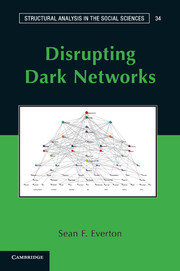Book contents
- Frontmatter
- Contents
- Figures
- Tables
- Preface
- Acknowledgments
- Part I Introduction
- Part II Social Network Analysis: Techniques
- Part III Social Network Analysis: Metrics
- 5 Network Topography
- 6 Cohesion and Clustering
- 7 Centrality, Power, and Prestige
- 8 Brokers, Bridges, and Structural Holes
- 9 Positions, Roles, and Blockmodels
- Part IV Social Network Analysis: Advances
- Part V Conclusion
- Appendix 1 The Noordin Top Terrorist Network
- Appendix 2 Glossary of Terms
- Appendix 3 Multidimensional Scaling with UCINET
- Appendix 4 The Just War Tradition
- References
- Index
7 - Centrality, Power, and Prestige
Published online by Cambridge University Press: 05 April 2013
- Frontmatter
- Contents
- Figures
- Tables
- Preface
- Acknowledgments
- Part I Introduction
- Part II Social Network Analysis: Techniques
- Part III Social Network Analysis: Metrics
- 5 Network Topography
- 6 Cohesion and Clustering
- 7 Centrality, Power, and Prestige
- 8 Brokers, Bridges, and Structural Holes
- 9 Positions, Roles, and Blockmodels
- Part IV Social Network Analysis: Advances
- Part V Conclusion
- Appendix 1 The Noordin Top Terrorist Network
- Appendix 2 Glossary of Terms
- Appendix 3 Multidimensional Scaling with UCINET
- Appendix 4 The Just War Tradition
- References
- Index
Summary
Introduction
Of all the social network analysis metrics, centrality is perhaps the most intuitive, which probably explains why it is one of the oldest concepts in social network analysis. Notions that certain actors are more central than others can be traced at least as far back as Jacob Moreno's (1953) conception of sociometric stars and isolates (Wasserman and Faust 1994:169), and its formal properties were among the first to be tested experimentally (Bavelas 1948, 1950; Leavitt 1951). Exchange theorists (Cook and Emerson 1978; Cook et al. 1983; Cook et al. 1986; Cook and Whitmeyer 1992; Emerson 1962, 1972a, b, 1976) built upon these early experiments to further our understanding of the relation between centrality and power, and scholars such as Linton Freeman (1977, 1979), Phillip Bonacich (1972a, 1987), Noah Friedkin (1991), and Steve Borgatti and Martin Everett (e.g., Borgatti 2005; Borgatti and Everett 2006; Everett and Borgatti 2005) have refined and expanded the measures of centrality available to analysts who have used them to explore a number of different social phenomena.
Researchers conceptualize centrality in a variety of ways (Bonacich 1987; Borgatti 2005; Borgatti and Everett 2006; Freeman 1979; Wasserman and Faust 1994). A central actor can be seen as someone who has numerous ties to other actors (e.g., degree centrality), as someone who has numerous ties to highly central actors (e.g., eigenvector centrality, hubs, and authorities), as someone who is close (in terms of path distance) to other actors in the network (e.g., closeness centrality), or as someone who lies on the shortest path between numerous pairs of actors in a network (e.g., betweenness centrality). These, of course, are not the only centrality measures available to researchers. In fact, if one takes into account the different available options, UCINET currently implements over twenty centrality measures. Most of these are variations of the aforementioned. Freeman (1979), in fact, argues that centrality measures can be sorted into three broad families or classifications: degree-like centrality, closeness-like centrality, and betweenness-like centrality (Borgatti and Everett 2006). Indeed, close inspection of UCINET's centrality measure options (Network>Centrality and Power) reveals that this is how they are organized (Figure 7.1). While some may disagree with Freeman's classification, it does provide a useful starting point for our discussion of centrality.
- Type
- Chapter
- Information
- Disrupting Dark Networks , pp. 206 - 252Publisher: Cambridge University PressPrint publication year: 2012

